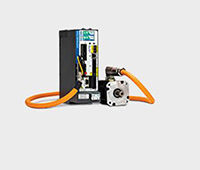
Ultrasonic welding was the only way to join the sensitive components of the chip while preserving their function.
Antibiotic-resistant infections represent a latent hazard for patients and a serious challenge for health care facilities. Greiner Bio-One, an international medical technology company, has created a test chip to help detect these infections. To create this chip, two pieces of polystyrene must be joined without disrupting the chips characteristics.
The test chip, called Genspeed, is used to detect MRSA (methicillin-resistant Staphylococcus aureus) infections—one of the world’s most frequently identified hospital pathogens. This test chip, apart from identifying the specific bacteria, can also detect the most important resistance genes, mecA and mecC. The chip is made up of two parts: a microfluidic polystyrene (PS) upper part and PS film on the bottom. On the film, specific capture molecules are deposited using capillary pressure.
The capture molecules are synthetic DNA sequences that represent the counterpart to the resistance genes in the test solution. During the test, reaction fluids are added sequentially to the test chip. That is a challenge for the joining technique for three reasons: First, the bonded parts must be absolutely leak-tight, second, a perfect visual appearance is indispensable in medical technology and crucial for the subsequent optoelectronic test evaluation, and finally a dimensionally perfect fit is needed, otherwise the flow behavior inside the reaction channel necessary for the sensitivity of the Genspeed test is impaired.
To ensure the transport of liquid through the microfluidic channel into the “waste reservoir,” the collecting vessel for the reaction fluids has to be reproducibly identical. Only a sensitive joining method, such as ultrasonic welding with exact parameterization, can satisfy this demand.
The parts are very delicate with a thickness of 1.5 mm for the upper part and 0.15 mm for the film. The upper and lower parts are joined by welding a 0.1-mm-high energy director along the microfluidic structure. These energy directors define where the melting begins. A reaction channel measuring 30 x 2 x 0.1 mm is created in which the individual test steps are performed by capillary action. A further energy director runs around the outer contour of the upper part to fix the complete film. In the waste reservoir, there are four small spacer domes, which ensure the film is positioned flat under the waste area.
One advantage of the ultrasonic technique is the targeted energy input, which permits controlled and dimensionally stable melting. Thanks to the special joint design, the ultrasonic waves are focused onto the joint zone without exerting a thermal burden on the part. The joint design for injection-molded parts consists of appropriate welding geometries with peaks or edges in the joint zone. During the course of the process optimization, the welding tool or “sonotrode” surface is partially milled away outside the seam geometries; this improves the focus of the ultrasonic waves, prevents coupling at the surface and results in a lower mechanical impact for the film.
The welding process can be defined and optimized using a variety of weld modes. This is beneficial, as materials react differently and part forms can be more demanding. For the Genspeed test chip, a miniature part, the melt distance measured from a “reference zero point” is defined as a fixed shutdown parameter, meaning the ultrasonic vibrations are switched off when the programmed weld depth is reached.

Parts of the chip are joined together with energy directors, shown in red, that define where melting begins.
The software validations are important for the welding process demanded by the regulatory requirements in the in-vitro diagnostics sector, which the HiQ DIALOG ultrasonic welding machine offers. Regulations require all production steps be protected by passwords, authorization packages and logbooks are created, and extensive software audit possibilities are available. The FDA Software Component (FSC) from Herrmann Ultrasonics offers extensive user authentication and monitoring of the authorizations. All parameter changes and user actions are recorded in electronic audit trails. If a parameter is changed, the previous values can be called up again at any time. This type of traceability of production steps has already been important in certain branches for many years, such as in the pharmaceuticals and food industries. The FSC software satisfies the demands of the FDA (Food and Drug Administration) Directive CFR 21 Part 11.
Herrmann Ultrasonics
Herrmannultrasonics.com
Filed Under: Medical-device manufacture, MOTION CONTROL, MORE INDUSTRIES





Tell Us What You Think!